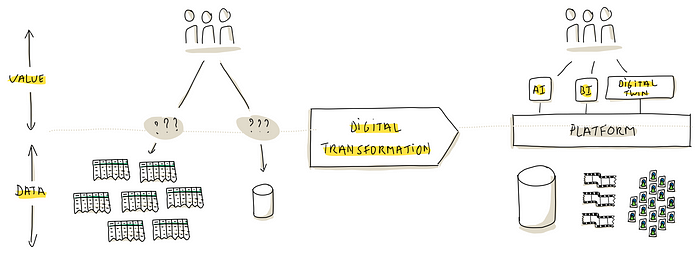Digital Transformation
Digital transformation not a magic solution nor a buffet of word salads. DT is roughly defined as the integration of digital technologies into all areas of a business, fundamentally changing how it operates, this process promises to reshape customer interactions, streamline operations, and unlock new avenues for innovation. In fact, research from the MIT Center for Digital Business (as referred to by Kalra et al.) suggests that companies embracing digital transformation are 26% more profitable and enjoy a 12% higher market valuation than their industry peers. What such studies don’t relate is that 2/3 of DT projects fail.

According to ‘The Digital Transformation Handbook’, the ultimate goal of digital transformation is to create digital enterprises — organizations that leverage technology to continually evolve their business models, offerings, customer relationships, and internal operations. This evolution is ongoing, mirroring the rapid pace of technological advancement. For businesses, the question is no longer whether to transform but how to do so effectively.
As described in ‘A Field Guide for Digital Transformation’, a transformation encompasses two key dimensions:
- External Transformation: Revolutionizing how a business interacts with the outside world, particularly in terms of customer perception and engagement. This can include enhancing online presence, personalizing customer experiences, and leveraging social media for marketing and communication. It can lead to increased customer satisfaction, expanded market reach, and ultimately, higher revenue.
- Internal Transformation: Reimagining internal operations, often requiring increased collaboration between departments, as well as between humans and machines. This might involve implementing automation to reduce manual tasks, utilizing data analytics for data-driven decision-making, and adopting agile methodologies to foster innovation. By optimizing internal processes, companies can improve efficiency, reduce costs, and enhance their overall agility.
Digital transformation, when approached strategically, can be a powerful catalyst for growth and innovation. By embracing digital technologies and adapting their business models, organizations can position themselves for success in an increasingly digital world.
Catalyst
Digital transformation acts as a catalyst for data-driven initiatives by shifting organizations towards automated and digitized processes. By replacing inefficient manual workflows (often driven by spreadsheets and shadow IT solutions) with streamlined digital systems, companies naturally begin to capture and store vast amounts of structured data. This wealth of information fuels a range of data-driven initiatives, unlocking new opportunities for growth and optimization:
- Data-Driven Management: Implementing key performance indicators (KPIs) based on real-time data empowers managers to make informed decisions rather than relying on intuition. This data-driven approach allows organizations to track progress towards strategic goals, identify areas for improvement, and proactively address challenges.
- Operational Reporting: By monitoring processes through tactical and operational reports, organizations can assess parameters like process efficiency, effectiveness, and product quality. This data-driven feedback loop enables continuous improvement, ensuring that processes are optimized for maximum output and value.
- Artificial Intelligence (AI): AI algorithms thrive on data. With access to large, structured and unstructured datasets, AI can uncover hidden patterns, automate repetitive tasks, and even generate creative content through generative AI. Digital transformation provides the foundation for AI adoption, enabling organizations to harness the power of machine learning for various applications.
- Digital Twins: Real-time data collection, made possible by digital transformation, allows for the creation of digital twins — virtual replicas of physical systems or processes. These digital representations can be used to monitor, analyze, simulate, and optimize operations in a safe and controlled environment, leading to increased efficiency and reduced risk.

In essence, digital transformation and data-driven initiatives are two sides of the same coin. A successful digital transformation not only generates valuable data but also fosters a data-centric culture within the organization. This culture prioritizes data-driven decision-making, empowering employees to use data to solve problems, identify opportunities, and drive innovation.
Conversely, data is the lifeblood of digital transformation. Without a clear understanding of how to collect, analyze, and utilize data, organizations will struggle to achieve the full benefits of their digital investments. A data-driven approach is essential for identifying bottlenecks, measuring the impact of digital initiatives, and ensuring that technology is being used to its fullest potential.
In any case DT is very hard. It needs a cloud-based strategy, plan, tooling, detailed architectures, POCs and MVPs and a dedicated team, as well as top management support and budgeting. Most DT projects fail -not due to technology, but due to organisational disorganisation and lack of focus.